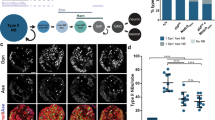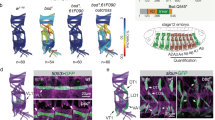Abstract
MUCH of our present knowledge of the biological processes involved in pattern formation in Drosophila is derived from segmentation analysis1, 2. Comparatively little is known about the genetic requirement and mechanisms underlying the formation and separation of germ layers by morphogenetic movements during gastrulation3. Here we show that theDrosophila gene huckebein (hkb), a member of the gap-gene class of segmentation genes4, 5, is required for germ-layer formation at blastoderm. Absence of the hkb product, an Sp1/egr-like zinc-finger protein, causes the ectodermal and mesodermal primordia to expand at the expense of endoderm anlagen. Conversely, ectopic expression of hkb inhibits the formation of the major gastrulation fold which gives rise to the mesoderm and prevents normal segmentation in the ectoderm. Thus, hkb is necessary for endoderm development and its activity defines spatial limits within the blastoderm embryo in which the germ layers are established.
This is a preview of subscription content, access via your institution
Access options
Subscribe to this journal
Receive 51 print issues and online access
$199.00 per year
only $3.90 per issue
Buy this article
- Purchase on Springer Link
- Instant access to full article PDF
Prices may be subject to local taxes which are calculated during checkout
Similar content being viewed by others
References
Hoch, M. & Jäckle, H. Curr. Opin. genet. Dev. 3, 566–573 (1993).
St Johnston, D. & Nüsslein-Volhard, C. Cell 68, 201–219 (1992).
Costa, M., Sweeton, D. & Wieschaus, E. in The Development of Drosophila (eds Bate, M. & Martinez-Arias, A.) (Cold Spring Harbor Laboratory Press, New York, 1992).
Weigel, D., Jürgens, G., Klingler, M. & Jäckle, H. Science 248, 495–498 (1990).
Brönner, G. & Jäckie, H. Mech. Dev. 35, 205–211 (1991).
Campos-Ortega, J. A. & Hartenstein, V. The Embryonic Development of Drosophila melanogaster (Springer, Berlin, 1985).
Foe, V. E. Development 107, 1–22 (1989).
Technau, G. M. & Campos-Ortega, J. A. Roux's Arch. dev. Biol. 194, 196–212 (1985).
Skaer, H. in The Development of Drosophila (eds Bate, M. & Martinez-Arias, A.) (Cold Spring Harbor Laboratory Press, New York, 1993).
Leptin, M., Casal, J., Grunewald, B. & Reuter, R. in Gastrulation (eds Stern, C. & Ingham, P. W.) 23–31 (The Company of Biologists, Cambridge, 1992).
Pignoni, F. et al. Cell 62, 151–159 (1990).
Bellen, H. J. et al. Genes Dev. 3, 1301–1313 (1989).
Oliver, G. et al. Mech. Dev. 44, 3–116 (1993).
Courey, A. J. & Tjian, R. Cell 55, 887–898 (1988).
Han, K. & Manley, J. L. Genes Dev. 7, 491–503 (1993).
Steingrimsson, E., Pignoni, F., Liaw, G.-J. & Lengyel, J. A. Science 254, 418–422 (1991).
Wolpert, L. in Gastrulation (eds Stern, C. & Ingham, P. W.) 7–13 (The Company of Biologists, Cambridge, 1992).
Beddington, R. S. P. & Smith, J. C. Curr. Opin. genet. Dev. 3, 655–661 (1993).
Krumlauf, R. Curr. Opin. genet. Dev. 3, 621–625 (1993).
Morata, G. Curr. Opin. genet. Dev. 3, 606–614 (1993).
Lai, Z. C., Fortini, M. E. & Rubin, G. M. Mech. Dev. 34, 123–134 (1991).
Turner, F. R. & Mahowald, A. P. Devl Biol. 57, 403–416 (1977).
Joseph, L. J. et al. Proc. natn. Acad. Sci. U.S.A. 85, 7164–7168 (1988).
Wimmer, E. A., Jäckie, H., Pfeifle, C. & Cohen, S. M. Nature 366, 690–694 (1993).
Rubin, G. M. & Spradling, A. C. Nucleic Acids Res. 11, 6341–6351 (1983).
Suggs, S. V., Katzowitz, J. L., Tsai-Morris, C. & Sukhatme, V. P. Nucleic Acids Res. 18, 4283 (1990).
Patwardhan, S. et al. Oncogene 6, 917–928 (1991).
Mohler, J., Eldon, E. D. & Pirrotta, V. EMBO J. 8, 1539–1548 (1989).
Rothe, M., Pehl, M., Taubert, H. & Jäckie, H. Nature 359, 156–159 (1992).
Brown, N. H. & Kafatos, F. C. J. molec. Biol. 168, 17–33 (1988).
Author information
Authors and Affiliations
Rights and permissions
About this article
Cite this article
Brönner, G., Chu-LaGraff, Q., Doe, C. et al. Sp1/egr-like zinc-finger protein required for endoderm specification and germ-layer formation in Drosophila. Nature 369, 664–668 (1994). https://doi.org/10.1038/369664a0
Received:
Accepted:
Issue Date:
DOI: https://doi.org/10.1038/369664a0
This article is cited by
-
The study of Priapulus caudatus reveals conserved molecular patterning underlying different gut morphogenesis in the Ecdysozoa
BMC Biology (2015)
-
The gap gene network
Cellular and Molecular Life Sciences (2011)
-
A MAPK docking site is critical for downregulation of Capicua by Torso and EGFR RTK signaling
The EMBO Journal (2007)
-
Huckebein-mediated autoregulation of Glide/Gcm triggers glia specification
The EMBO Journal (2006)
-
Capicua integrates input from two maternal systems in Drosophila terminal patterning
The EMBO Journal (2004)
Comments
By submitting a comment you agree to abide by our Terms and Community Guidelines. If you find something abusive or that does not comply with our terms or guidelines please flag it as inappropriate.



